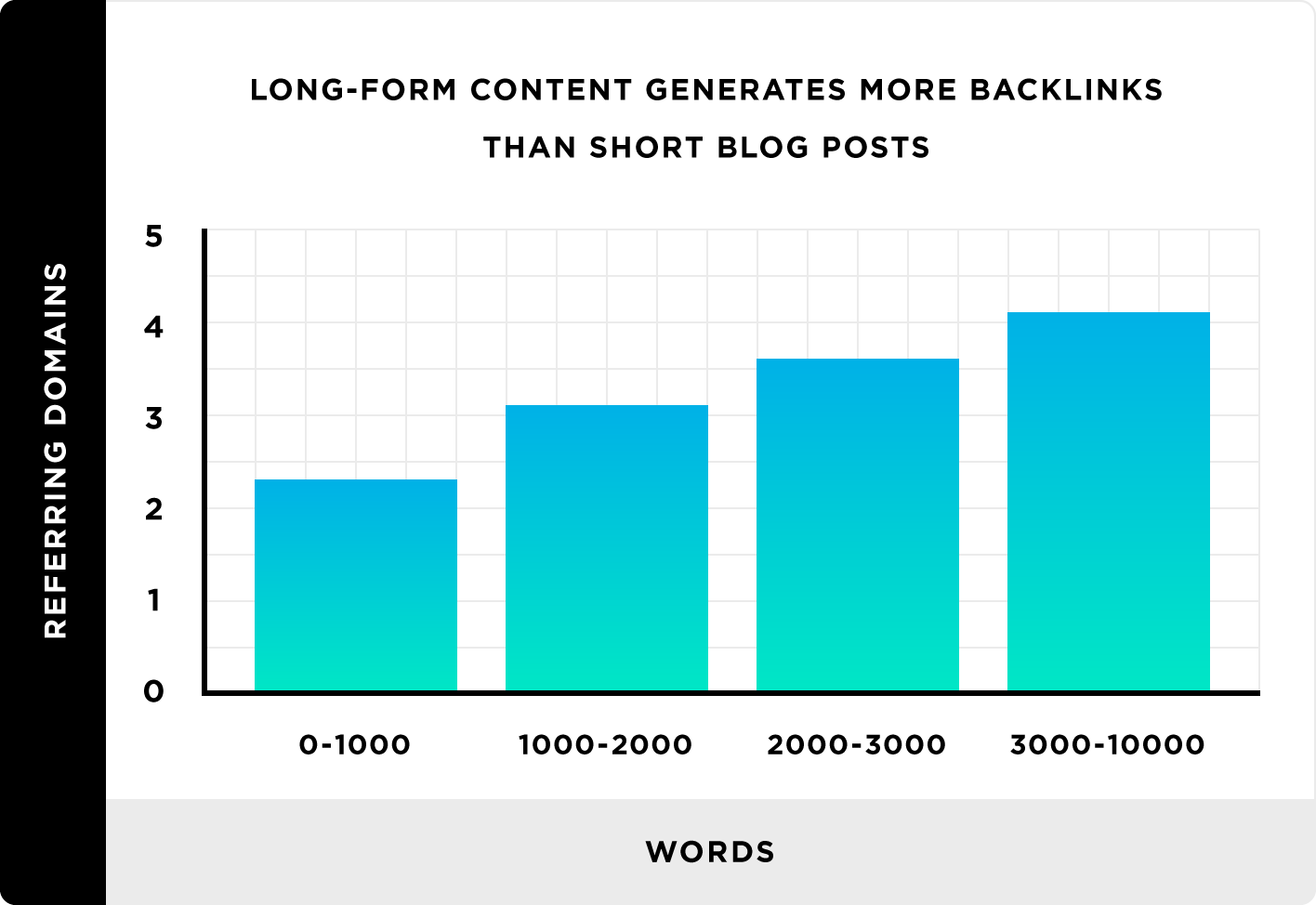 This article is brought to you by Kelly Boyer Sagert, an experienced, full-time freelance writer who specializes in writing longform blog posts and is part of an Emmy-Award nominated team. She is also a member of Jottful Community.
This article is brought to you by Kelly Boyer Sagert, an experienced, full-time freelance writer who specializes in writing longform blog posts and is part of an Emmy-Award nominated team. She is also a member of Jottful Community.
Build it and they will come.
If you’re a baseball fan or film aficionado, you’ll likely recognize this quote.

And, while it ultimately proved true for Kevin Costner’s character in Field of Dreams, when it comes to writing blog posts, the quote should be more like this:
Build, optimize, and promote your blog posts so that your targeted audience will come.
I’m the first to agree that the second version is nowhere near as catchy as the first, but it’s a much more realistic approach.
Why write longform content?
As studies have shown for several years now, to obtain the most visible spots in Google’s search engine results pages (SERPs), you should write longform content.
In 2012, serpIQ reviewed content that appeared on page one in Google SERPs for targeted keywords. They found that, on average, all ten pieces of content appearing on that coveted page contained more than 2,000 words. The average length for a #1 ranking was, on average, 2,416 words. The number ten spot? 2,032 words.

Given those results, it isn’t surprising that the term “longform content” is often defined as a page or post having at least 2,000 words.
In 2013, Google announced that they were going to start highlighting select in-depth articles in the SERPs (the article with the announcement now contains outdated info, but it doesn’t retract the importance of in-depth content).
So, as a foundation, longform content can be defined as a web page containing at least 2,000 words.
Having said that, one of the kings of successful online content, Neil Patel, is now recommending 3,000+-word posts, saying the following about his flagship site: “all of my articles are 4000+ words. And, in a year, I’ve already crossed 100,000 visitors/month.”
Now, is success just about the number of words?
No.
Simply writing more words is not the ticket.
Writing in-depth posts that provide your targeted audience with the information they need to solve problems or improve their quality of life, though, is both a worthy goal and one that may reward your company—especially if you optimize the posts well and promote them effectively.
Creating longform content can help you engage with your audience, position yourself and your company as an authority on crucial subjects, and much more. Before discussing how to write longform content, let’s take a quick look at a 2019 Backlinko.com study.

In it, Backlinko.com — along with their data partner, Buzzsumo — analyzed 912 million blog posts to determine what works best to attract readers, and discovered that longform content gets, on average, 77.2 percent more backlinks (inbound links) than short pieces. Because there is a close relationship between Google rankings and the quantity, quality, and diversity of inbound links, this study helps to reverse engineer why well-written, targeted longform blog posts can become so visible online, positioned to attract the traffic your business wants and needs.
Tips from the trenches: how to write quality longform posts
I say “from the trenches” because I regularly write longform posts for clients and have done so for several years. Since most of the posts are ghostwritten (containing the name and bio of the client who hired me in the byline), there aren’t huge numbers of longform posts that openly display my name.
Fortunately, about three years ago, two companies allowed me to use longform posts I’d written for them to demonstrate the nuts and bolts of writing them — described and analyzed in a longform post that does contain my byline. That info has been published in a post titled Attract Google’s Attention With Long-Form Content.
Now, here are some tips!
1. Create an editorial calendar
What interests your audience? In general, you’ll want to create longform posts that are educational and informative without being heavy-duty promotional about your products and services.
To discover those interests, you can use online tools, such as these:
- SEMrush.com’s keyword tool (fee-based)
- Google Trends
- HubSpot’s Blog Idea Generator
- Answer the Public
You can find more tools to see how people are searching here.
To find out, even more specifically, what your specific audience wants to know, you can also:
- See which of your blog posts have engaged people the most so far.
- Ask people in your company with direct customer contact what questions they’re often asked.
- Conduct prospect and customer surveys to find out their interests.
Armed with these insights, you can create an editorial calendar. HubSpot has an editorial calendar template you might want to use. So does Content Marketing Institute, among many others—or you can use Microsoft Excel, Google Sheets or another spreadsheet to create your own.

As you create your calendar, list:
- How often you want to blog
- Dates when you want to publish posts
- Your topics
- Which posts will be longform
Does your editorial calendar include a good balance of topics from the various parts of your business? Do you have posts planned for the holidays? In connection with special events for your business?
Now is the time to create a publishing plan that really works.
From this point on, this post will focus on how to develop the posts you’ve marked as longform.
2. Right-size your longform post
In other words, follow the Goldilocks principle. She first tasted porridge that was too hot—and then too cold—before finding a bowl that was just right.
When choosing a blog topic, you want to avoid ones that are too broad or too narrow for your intended length, instead choosing one that is . . . yep, just right.
Many years ago, when I was writing for print, someone taught me the Rule of 7. This rule helps you take a broad topic and right-size it for an article (or blog post). So, let’s say you’ve got a website where you match online prospects with quality dog trainers in their area. You therefore want to create blog content that demonstrates why having a well-trained dog can improve the quality of a customer’s life.
Here’s how you might use the Rule of 7, noting that some of these steps are so intuitive that you may quickly be able to get to level three or four. You first list a broad topic and then continue to narrow it down six times. Be careful that you are actually narrowing it, though, not listing a topic that’s similar in size and scope.
Here goes!
Level 1: Dogs
Level 2: Pet dogs
Level 3: Activities for pet dogs
Level 4: Activities for pet dogs and their owners to enjoy together
Level 5: Exercising with your pet dog
Level 6: Exercising with your pet dog to lose weight
Level 7: Ten Ways to Exercise With Your Dog to Lose Weight

You can see how targeted this becomes, while still giving you plenty of room in this topic to create content. For example, you could: craft a 250-word introduction; spend 250 words on each of the ten ways you’ll describe; and add a 250-word conclusion and call to action. Now you’ve got a 2,500-word longform blog post that’s chock-full of targeted and useful information!
3. Structure your post
Posts that are “Ten Ways to . . .” structure themselves pretty naturally. That, however, isn’t always the case.

So, I’ll return to the two longform blog posts that clients gave me permission to discuss.
One post was for Ocean Systems, Inc., designer of the underwater camera, SplashCam, used by The Deadliest Catch on the Discovery Channel. The topic I came up with was Underwater Cameras: See (and Explore) New Frontiers, which allowed target audiences to observe the amazing ways in which underwater cameras can be used.
I used this structure:
- I opened with a broad and sweeping paragraph that shares the incredible adventure of underwater exploration and included this statement: “approximately 71% of our planet is water – and an in-depth 2012 study estimates that 700,000 to one million species live in our oceans, with one-third to two-thirds not yet named or even described. This means there are literally hundreds of thousands of marine life species waiting for someone to capture them on video and share them with the world.”
- Because this topic easily lends itself to visuals—and because people click through videos at a high rate — I then shared three videos of fascinating underwater life.
- Next, I introduced the concept of underwater video cameras to give them thumbs up for providing us with the technical ability to share the beauty and wonder of the underwater world.
- I segued from that into the history and timeline of these cameras, including an original infographic and even more videos to keep readers engaged. These included but weren’t limited to marine archaeology.
- As I transitioned into even more uses of these cameras, it was pretty seamless to start mentioning how SplashCam.com’s cameras were used on The Deadliest Catch—and to then include a compelling testimonial from the program directors after they were nominated for their third Emmy Award for Outstanding Cinematography.
- The longform piece ended with a call to action that shared how readers could rent or buy their own SplashCam underwater cameras for their own unique adventures.
You can see more details about the construction of this piece of longform content in the post I wrote at FreelanceWritingRiches.com. And, you can also see how, for the second piece of in-depth content, I hunted down the ghost that inhabited Cool Savannah, a business that gave tours—including but not limited to ghost tours—in historic Savannah, Georgia.
In this longform piece, I interviewed Ryan Dunn of the Savannah Ghost Research Society after their investigation of the Cool Savannah building. I then:
- Read reporting from 6th Sense World founder Shannon Scott, who said the following: “I can’t explain why the C[ool] Savannah building is like this toll booth on the spirit world highway, but it’s definitely like nothing I have ever seen or studied in any other Savannah building. In my intuitive estimation, it fits the profile of a thoroughfare that spirits us to enter and leave Savannah.”
- Talked to people who worked at the touring company about reports of a female ghost in a Victorian-style dress who had “something wrong” with her neck
- Did historical research about women hanged in that time and place
After settling on Susan Eberhardt as the ghost (a woman hanged for helping her lover to kill his wife), I shared why Cool Savannah was her choice of site to haunt—and encouraged readers to come to the building for themselves, adding when ghost tours were taking place and how people could sign up.
4. Pay attention to the nuts and bolts

To create a quality longform post (or virtually any blog post, for that matter), it’s important to:
- Use solid sources of information, whether primary (interviews, for example) or secondary (such as other reputable published pieces)
- Choose core keywords and optimize the post for those terms to direct targeted traffic to the website
- Include quality images, including photos (here’s more on that subject)
- Include internal links to other content on your site (as I just demonstrated in the bullet point above)
- Include outbound links to authoritative pieces of information (as I did throughout the post)
- Add sub-headings that make the post easy to read and scan
5. Make revisions after the draft is finished
Here are questions to ask yourself:
- Does the piece flow well?
- Is the beginning compelling?
- Does the ending wrap up what needs to be known?
- Are there any spelling, grammar, or punctuation errors that need fixed?
- Do all the links work and go to the intended URLs?
- Have I given credit to anyone quoted or summarized?
- Does the amount I’ve quoted or summarized fit within fair use guidelines?
- Do I have permission to use images?
- If so, how should they be attributed?
- Does my “call to action” make sense?
- What is my promotional plan for this piece?
- How will I get inbound links and social shares?

Here’s something else to consider. Once you decide to use longform content to become more visible on Google, it’s important to take a look at what your competitors are doing. To do that, enter your desired main keyword into the Google search box. What are the highest-ranking posts on the subject? How long are they? If they’re under 2,000 words, that’s a good sign.
If top competitors, though, are ranking with 3,000-word pieces, then you’ll likely need to expand your post lengths to achieve the rankings you desire.
Bonus Tip
At regularly scheduled times (perhaps quarterly or annually), review the blog posts on your site to see whether they need to be updated.
If so, update them and, at the top of the post, put the date in which you did this. That way, readers can be comfortable knowing that they’re reading up-to-date info.
As part of this process, look for ways to add even more value to your blog posts. For example, let’s say a new marine archaeology discovery has hit the news since I first wrote the longform post on underwater video cameras. In that case, it probably makes sense to add that information. Could I get an interview with someone involved? Share a video?
Here’s something else to consider. If you realize that you need to add longform content to your website—but you don’t have the resources to invest in that effort right now — you could first focus on transforming current posts into longform ones.
What’s most important? Getting started, ASAP!




